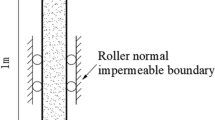Abstract
Liquefaction can result in the damage or collapse of structures during an earthquake and can therefore be a great threat to life and property. Many site investigations of liquefaction disasters are needed to study the large-scale deformation and flow mechanisms of liquefied soils that can be used for performance assessments and infrastructure improvement. To overcome the disadvantages of traditional flow analysis methods for liquefied soils, a soil–water-coupled smoothed particle hydrodynamics (SPH) modeling method was developed to analyze flow in liquefied soils. In the proposed SPH method, water and soil were simulated as different layers, while permeability, porosity, and interaction forces could be combined to model water-saturated porous media. A simple shear test was simulated using the SPH method with an elastic model to verify its application to solid phase materials. Subsequently, the applicability of the proposed SPH modeling method to the simulation of interaction forces between water and soil was verified by a falling-head permeability test. The coupled SPH method produced good simulations for both the simple shear and falling-head permeability tests. Using a fit-for-purpose experimental apparatus, a physical flow model test of liquefied sand has been designed and conducted. To complement the physical test, a numerical simulation has been undertaken based on the soil–water-coupled SPH method. The numerical results correspond well with the physical model test results in observed configurations and velocity vectors. An embankment failure in northern Sweden was selected so that the application of the soil–water-coupled SPH method could be extended to an actual example of liquefaction. The coupled SPH method simulated the embankment failure with the site investigation well. They have also estimated horizontal displacements and velocities, which can be used to greatly improve the seismic safety of structures.















Similar content being viewed by others
References
Batchelor GK (1967) An introduction to fluid dynamics. Cambridge University Press, UK
Bhattacharya S, Hyodo M, Goda K, Tazoh T, Taylor CA (2011) Liquefaction of soil in the Tokyo Bay area from the 2011 Tohoku (Japan) earthquake. Soil Dyn Earthq Eng 31(11):1618–1628
Biot MA (1941) General theory of three-dimensional consolidation. J Appl Phys 12:152–164
Bui HH, Fukagawa R, Sako K, Ohno S (2008) Lagrangian meshfree particles method (SPH) for large deformation and failure flows of geomaterial using elastic–plastic soil constitutive model. Int J Numer Anal Meth Geomech 32(12):1527–1570
Ekstrom A, Olofsson T (1985) Water and frost-stability risks for embankments of fine-grained soils. In: Proceedings of symposium on failures in earthworks, Institution of Civil Engineers, London, Telford (Thomas) Ltd., London, UK, pp 155–166
Gray JP, Monaghan JJ, Swift RP (2001) SPH elastic dynamics. Comput Methods Appl Mech Eng 190(49–50):6641–6662
Hadush S, Yashima A, Uzuoka R (2000) Importance of viscous fluid characteristics in liquefaction induced lateral spreading analysis. Comput Geotech 27(3):199–224
Hadush S, Yashima A, Uzuoka R, Moriguchi S, Sawada K (2001) Liquefaction induced lateral spread analysis using the CIP method. Comput Geotech 28(8):549–574
Huang Y, Jiang XM (2010) Field-observed phenomena of seismic liquefaction and subsidence during the 2008 Wenchuan earthquake in China. Nat Hazards 54(3):839–850
Huang Y, Zhang WJ, Mao WW, Jin C (2011) Flow analysis of liquefied soils based on smoothed particle hydrodynamics. Nat Hazards 59(3):1547–1560
Huang Y, Mao WW, Zheng H, Li GH (2012a) Computational fluid dynamics modeling of post-liquefaction soil flow using the volume of fluid method. Bull Eng Geol Environ 71(2):359–366
Huang Y, Zhang WJ, Xu Q, Xie P, Hao L (2012b) Run-out analysis of flow-like landslides triggered by the Ms 8.0 2008 Wenchuan earthquake using smoothed particle hydrodynamics. Landslides 9(2):275–283
Liu GR, Liu MB (2003) Smoothed particle hydrodynamics: a mesh-free particle method. World Scientific Press, Singapore
Lucy LB (1977) A numerical approach to the testing of the fission hypothesis. Astron J 82(12):1013–1024
Maeda K, Sakai H, Sakai M (2006) Development of seepage failure analysis method of ground with smoothed particle hydrodynamics. J Struct Earthq Eng JSCE Div A 23(2):307–319
Monaghan JJ (1988) An introduction to SPH. Comput Phys Commun 48:89–96
Morris JP, Fox PJ, Zhu Y (1997) Modeling low Reynolds number incompressible flows using SPH. J Comput Phys 136:214–226
Pastor M, Haddad B, Sorbino G, Cuomo S, Drempetic V (2008) A depth-integrated, coupled SPH model for flow-like landslides and related phenomena. Int J Numer Anal Meth Geomech 33(2):143–172
Sawada K, Moriguchi S, Yashima A, Zhang F, Uzuoka R (2004) Large deformation analysis in geomechanics using CIP method. JSME Int J 47(4):735–743
Sugino T, Yuu S (2002) Numerical analysis of fine powder flow using smoothed particle method and experimental verification. Chem Eng Sci 57:223–237
Takeda H, Miyama M, Sekiya M (1994) Numerical simulation of viscous flow by smoothed particles hydrodynamics. Progress Theor Phys 92(5):939–960
Uzuoka R, Yashima A, Kawakami T, Konrad JM (1998) Fluid dynamics based prediction of liquefaction induced lateral spreading. Comput Geotech 22(3–4):243–282
Acknowledgments
This work was supported by the National Basic Research Program of China (973 Program, Grant No. 2012CB719803), the National Science Found for Distinguished Young Scholars of China (Grant No. 41225011), the Chang Jiang Scholars Program of China, the Changjiang Scholars and Innovative Research Team in University (Grant No. PCSIRT, IRT1029), and the Fundamental Research Funds for the Central Universities.
Author information
Authors and Affiliations
Corresponding author
Rights and permissions
About this article
Cite this article
Huang, Y., Zhang, W., Dai, Z. et al. Numerical simulation of flow processes in liquefied soils using a soil–water-coupled smoothed particle hydrodynamics method. Nat Hazards 69, 809–827 (2013). https://doi.org/10.1007/s11069-013-0736-5
Received:
Accepted:
Published:
Issue Date:
DOI: https://doi.org/10.1007/s11069-013-0736-5




